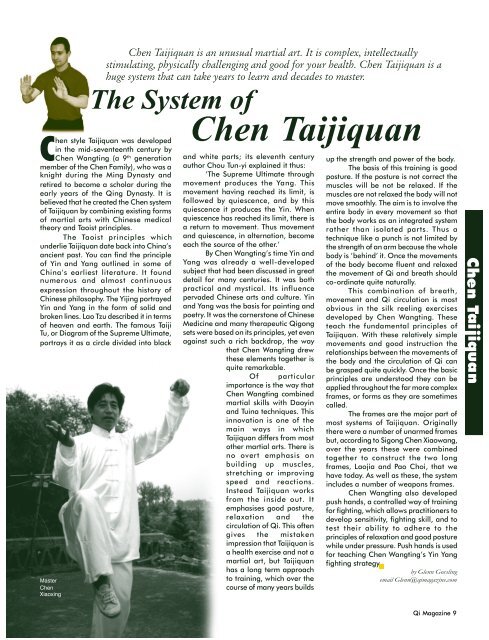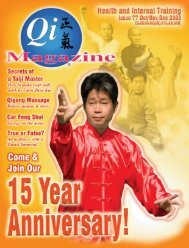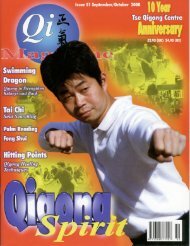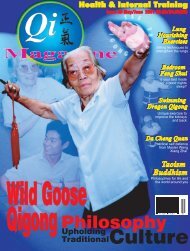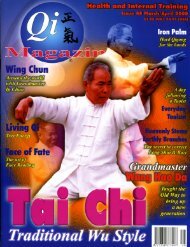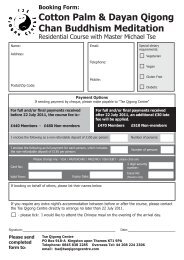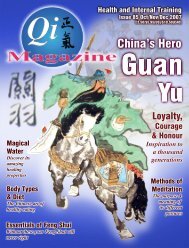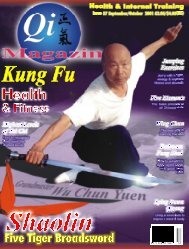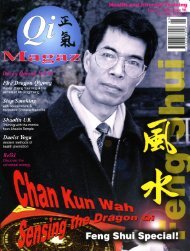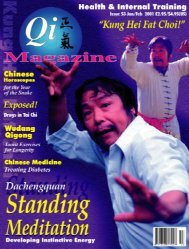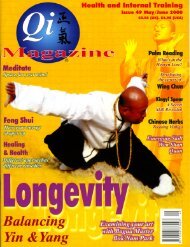Issue 54 - Tse Qigong Centre
Issue 54 - Tse Qigong Centre
Issue 54 - Tse Qigong Centre
- No tags were found...
You also want an ePaper? Increase the reach of your titles
YUMPU automatically turns print PDFs into web optimized ePapers that Google loves.
Chen style Taijiquan was developedin the mid-seventeenth century byChen Wangting (a 9 th generationmember of the Chen Family), who was aknight during the Ming Dynasty andretired to become a scholar during theearly years of the Qing Dynasty. It isbelieved that he created the Chen systemof Taijiquan by combining existing formsof martial arts with Chinese medicaltheory and Taoist principles.The Taoist principles whichunderlie Taijiquan date back into China’sancient past. You can find the principleof Yin and Yang outlined in some ofChina’s earliest literature. It foundnumerous and almost continuousexpression throughout the history ofChinese philosophy. The Yijing portrayedYin and Yang in the form of solid andbroken lines. Lao Tzu described it in termsof heaven and earth. The famous TaijiTu, or Diagram of the Supreme Ultimate,portrays it as a circle divided into blackMasterChenXiaoxingChen Taijiquan is an unusual martial art. It is complex, intellectuallystimulating, physically challenging and good for your health. Chen Taijiquan is ahuge system that can take years to learn and decades to master.The System ofChen Taijiquanand white parts; its eleventh centuryauthor Chou Tun-yi explained it thus:‘The Supreme Ultimate throughmovement produces the Yang. Thismovement having reached its limit, isfollowed by quiescence, and by thisquiescence it produces the Yin. Whenquiescence has reached its limit, there isa return to movement. Thus movementand quiescence, in alternation, becomeeach the source of the other.’By Chen Wangting’s time Yin andYang was already a well-developedsubject that had been discussed in greatdetail for many centuries. It was bothpractical and mystical. Its influencepervaded Chinese arts and culture. Yinand Yang was the basis for painting andpoetry. It was the cornerstone of ChineseMedicine and many therapeutic <strong>Qigong</strong>sets were based on its principles, yet evenagainst such a rich backdrop, the waythat Chen Wangting drewthese elements together isquite remarkable.Of particularimportance is the way thatChen Wangting combinedmartial skills with Daoyinand Tuina techniques. Thisinnovation is one of themain ways in whichTaijiquan differs from mostother martial arts. There isno overt emphasis onbuilding up muscles,stretching or improvingspeed and reactions.Instead Taijiquan worksfrom the inside out. Itemphasises good posture,relaxation and thecirculation of Qi. This oftengives the mistakenimpression that Taijiquan isa health exercise and not amartial art, but Taijiquanhas a long term approachto training, which over thecourse of many years buildsup the strength and power of the body.The basis of this training is goodposture. If the posture is not correct themuscles will be not be relaxed. If themuscles are not relaxed the body will notmove smoothly. The aim is to involve theentire body in every movement so thatthe body works as an integrated systemrather than isolated parts. Thus atechnique like a punch is not limited bythe strength of an arm because the wholebody is ‘behind’ it. Once the movementsof the body become fluent and relaxedthe movement of Qi and breath shouldco-ordinate quite naturally.This combination of breath,movement and Qi circulation is mostobvious in the silk reeling exercisesdeveloped by Chen Wangting. Theseteach the fundamental principles ofTaijiquan. With these relatively simplemovements and good instruction therelationships between the movements ofthe body and the circulation of Qi canbe grasped quite quickly. Once the basicprinciples are understood they can beapplied throughout the far more complexframes, or forms as they are sometimescalled.The frames are the major part ofmost systems of Taijiquan. Originallythere were a number of unarmed framesbut, according to Sigong Chen Xiaowang,over the years these were combinedtogether to construct the two longframes, Laojia and Pao Choi, that wehave today. As well as these, the systemincludes a number of weapons frames.Chen Wangting also developedpush hands, a controlled way of trainingfor fighting, which allows practitioners todevelop sensitivity, fighting skill, and totest their ability to adhere to theprinciples of relaxation and good posturewhile under pressure. Push hands is usedfor teaching Chen Wangting’s Yin Yangfighting strategyby Glenn Gosslingemail Glenn@qimagazine.comChen TaijiquanQi Magazine 9


